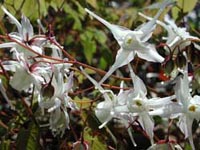Resource Library
Plant of the Week: Barrenwort
The University of Arkansas System Division of Agriculture does not promote, support or recommend plants featured in "Plant of the Week." Please consult your local Extension office for plants suitable for your region.
Plant of the Week
Barrenwort
Latin: Epimedium grandiflorum

Patience is a virtue. We all know the old refrain, but it always surprises me how few people really believe it, let alone practice it. Even gardeners fall into the impatience quagmire, often choosing fast growing and easy over slow, steady performers. Perhaps this explains why plants such as the Barrenwort are not more common in our gardens. They are plants to test the patience of gardeners, but they always reward in the end.
Of the several dozen epimediums available from nurserymen, the most common and one of the showiest is the white-flowered Epimedium grandiflorum. It grows about a foot tall with the white, four-pointed blooms held in panicles above the foliage in mid spring - about the time azaleas begin to bloom. It is native to Japan and Manchuria in China.
The flowers look like they were designed by a committee of Chinese artists intending to create something fantastic, yet still beautiful and delicate. The four long, narrow spurs radiate outwards and are about an inch and a half across. Below the petals are four petal-like sepals that are suffused with shades of purple or rose. The center of the flower protrudes outward forming an almost square opening through which pollinating insects reach the working of the flower.
The foliage is likewise beautiful. When flowering is finished the plants stand about eight inches tall with semi-evergreen leaves that take on a maroon cast in winter. They are not killed until temperatures reach about 15°F. Leaves are compounded with delicate, 2-inch long, asymmetrical leaflets produced in three groups of three (triternate) on wiry stem arising from the base of the plant. Epimediums belong to the barberry family, and like most members of that group, spread by means of an underground rhizome.
Now for the bad news. The planting of epimediums I am currently admiring was planted six years ago and each clump is only about a foot in diameter. To be honest, the first three years the plants were so small they were insignificant in my garden. But, since the third year the clump has steadily, all be it slowly, increased in size and beauty.
Epimediums are undergoing a surge in popularity unknown to this understated perennial. This increased popularity has all occurred since 1975 when plant explorers were permitted back into the mountains of western China. Of the 44 species now recognized by botanists, 36 have been introduced since the reopening of China to the West. Dan Hinkley, the proprietor of Heronswood Nursery in Kingston, Wash., has made several expeditions into the region and lists a number of his own introductions in his current catalog.
Epimediums are woodland plants that are often described as useful for groundcover planting. While they make excellent groundcovers, this is rarely ever seen because the plants are slow growing and expensive to procure. Most of us limit our admiration to modest clumps in an informal woodland garden or shaded rock garden.
A soil well amended with organic matter and moderately moist during the summer will speed growth and establishment, but they will survive more difficult conditions once established. One planting of E. grandiflorum I oversee is beneath a sugar maple in a raised bed. No matter how often this bed is watered, the soil is always bone dry, yet the plants continue to slowly expand. To fully appreciate the beauty of the plants, cut them back to the ground in late winter before new growth emerges in early spring. I have never noticed any insect interest in this plant.
By: Gerald Klingaman, retired
Extension Horticulturist - Ornamentals
Extension News - April 4, 2003
The University of Arkansas System Division of Agriculture does not maintain lists of retail outlets where these plants can be purchased. Please check your local nursery or other retail outlets to ask about the availability of these plants for your growing area.